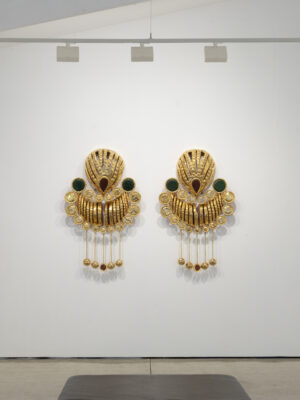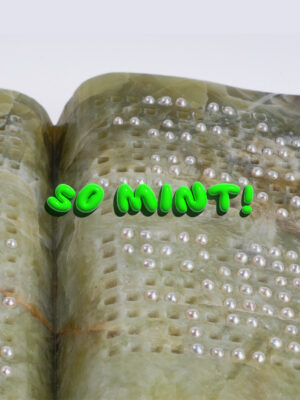As noted by postmodern theorists like Jean-François Lyotard and Jean Baudrillard, pillars such as religion and community are undergoing significant destabilisation. Yet, amidst this uncertainty, a profound realisation emerges: mythology, far from being obsolete, plays a crucial role in shaping our perception of reality.
Beyond mere storytelling, mythology can be used as a dynamic practice of worldbuilding, woven through symbols and objects that resonate deeply within our collective consciousness. In an era marked by existential angst and societal upheaval, we might find ourselves drawn to these symbolic artefacts, seeking solace and a sense of continuity amidst the chaos. This affinity can find expression in precious jewellery and accessories, which often hold emotional value. Here, the power of myth and storytelling merges with our most cherished belongings and emotions, imbuing them with a sense of magic and significance. In exploring this interplay, we uncover not only the enduring allure of myth but also its capacity to offer meaning and direction in a world where certainties are increasingly scarce.
Artists like Maxime Buono, SORCERER, and Joanne Burke tap into this power by creating narratives that deeply resonate with modern society, while also imagining beyond them. Through their work, these creators seamlessly blend current stories into semi-fictional tales, merging reality with imagination to envision new possibilities rooted in our own reality.


___STEADY_PAYWALL___
The Power of the Hero
Central to mythology is the archetype of the hero—a symbol of resilience and courage in the face of adversity. In today’s world, where environmental crises and social upheaval loom large, embracing our inner hero through myth becomes not just an act of escapism but also a powerful tool for navigating uncertainty.
Viewing our contemporary challenges through the lens of the hero’s journey infuses life with purpose and direction. A renowned science fiction writer, Ursula K. Le Guin, best known for her mythic tales that have influenced generations, underscores the transformative power of storytelling. Through her exploration of mythology, she highlights its ongoing relevance, suggesting that myths offer valuable insights into ourselves and our world. In Tales of Earthsea, a collection of fantasy stories and essays later adapted to film, characters discover their “true name,” symbolising the journey to self-discovery and finding one’s place in society. Le Guin’s narratives, steeped in myth and magic, not only entertain but also provide structure, wisdom, and solace, offering emotional support through storytelling.
Given this transformative power of mythology, the act of adorning ourselves with jewellery ingrained with mythic symbols becomes an intriguing act of self-discovery through embodied storytelling. By immersing ourselves in these semi-fictitious tales, we actively use mythology as an anchor, allowing it to re-emerge as a meaningful source that connects us to our archaic past and ancient wisdom, amidst the complexities of modern life. Just as characters in Ursula K. Le Guin’s narratives undergo transformative journeys guided by mythical forces, donning jewellery infused with symbolic meaning propels us towards personal evolution. The act of story building and attaching layered meanings to our belongings allows us to access a mindset of growth, inviting us to confront life’s challenges as narrative arcs to be traversed, empowering us to navigate our own stories of transformation.
The fusion of aesthetics with mythical narratives offers powerful tools for imagination, sparking a dialogue between reality and possibility. This transformation of jewellery into a medium where myths and contemporary discourse converge revitalises our imagination, particularly crucial in times of crisis.
The Journey of the Hero
While traditional views often associate myth with nostalgia, Buono, SORCERER, and Burke transcend that notion, engaging directly with contemporary discourse to construct fresh and highly relevant myths. Their works not only reflect the pulse of our times but also offer new frameworks for navigating existential questions and the complexities of modern life. But how does one become a hero within the contexts that they outline?
In a realm where the digital and physical worlds merge, Buono‘s necklaces serve as portals where ancient wisdom meets modern technology. By combining age-old traditions with today’s social media experiences, Buono provides a fresh perspective amid the prevailing narrative of technological dystopianism. Rather than succumbing to a grim future dominated by technology, he encourages active engagement with the evolving relationship between humans and technology, promoting engagement and empowerment.
This convergence of physical and virtual realms heralds the rise of digital realism, where truth transcends traditional notions of reality. In this era, heroes embark on nuanced journeys to uncover truths that extend beyond conventional realities, blurring the boundaries between truth and reality. This shift requires a sophisticated approach, particularly in the digital age, necessitating heroes who can discern the manipulation of truth to either advocate for new possibilities and freedom, or exert control and domination amidst the distorted realities of the digital realm.



Roland Barthes, a prominent theoretician on myth, explained that ‘Myth is not defined by the object of its message, but by the way in which it utters this message.’ This sentiment finds striking resonance in SORCERER‘s artistic approach, particularly evident in their use of recycled materials and boundary-blurring aesthetics. Their designs confront prevailing ideas of human progress that often position humanity as separate from or superior to nature. Instead, they prompt us to reassess our relationship with nature from a standpoint of greater balance and equality. They emphasise the importance of adopting a new narrative where humans aren’t portrayed as heroic conquerors of nature, but rather, the hero is one who embraces collaboration with the natural world. By celebrating decay, disintegration, and imperfection, they subvert conventional beauty standards that promote perfection and disposability. Through embracing regenerative practices, SORCERER‘s work not only critiques but also reshapes humanity’s path forward. Similarly, their collaborative approach within their collective highlights the strength of collective endeavour, mirroring the interconnectedness seen within natural ecosystems.
Similarly, Burke‘s innovative manipulation of metals prompts us to reconsider humanity’s narrative of progress. Her work not only reconnects us with our history and technological advancements but also with the ancient qualities embedded in objects through alchemical metal-crafting techniques. By tracing an object’s existence within history and nature, Burke revitalises its material significance, granting nature its own narrative alongside humanity. This leads to the creation of hybrid objects that offer new perspectives on our relationship with the world, where nature assumes a heroic role alongside humanity and technology.

The fusion of aesthetics with mythical narratives offers powerful tools for imagination, sparking a dialogue between reality and possibility. This transformation of jewellery into a medium where myths and contemporary discourse converge revitalises our imagination, particularly crucial in times of crisis. These works remind us of our interconnectedness and foster unity, empowering us to navigate the challenges of our technological futures and changing climate.
Exploring mythology in today’s world can lead to profound self-discovery and collective growth. Mastering the transformative power of storytelling grants us significant influence over the shape of our future realities, both as individuals and societies.
As we adorn ourselves with myth-infused jewellery, we embark on a journey as heroes in the face of contemporary challenges. This act signifies our role as navigators of our own mythological narratives, where we must determine the kind of heroes we aspire to be. Will we be the ones who embrace the intricate nuances of digital realism, reparative circularity, and material awareness, paving the way for resilience and purpose in the future?
This article is part of a larger exploratory series called Urban Mythology commissioned by Current Obsession. The theme blends personal mythology and modernised traditions to present a new take on identity, oral history, and symbolic language. Reclaiming history and decolonising the past and future through innovative narratives and in-depth research, it examines anything from beliefs, (cyber) deities, folklore, shamanism, to the creative prowess of multicultural artists. Diving into a world where ethereality meets living jewellery, where history is not just retold but reimagined. Urban Mythology seeks to explore the richness of our past and present, redefining our traditions and propelling us towards an uncharted future.
Tiiu Meiner is an Estonian curator and writer based in Rotterdam, NL. Central to Meiner’s work are socio-political discourses in daily lived experiences. She particularly creates work focussing on language as a material and the design of narratives about nature and social hierarchies. Her multidisciplinary outcomes encompass exhibitions, poetry, essays, panel discussions and film.
Cover image by SORCERER. Courtesy of the artist.



